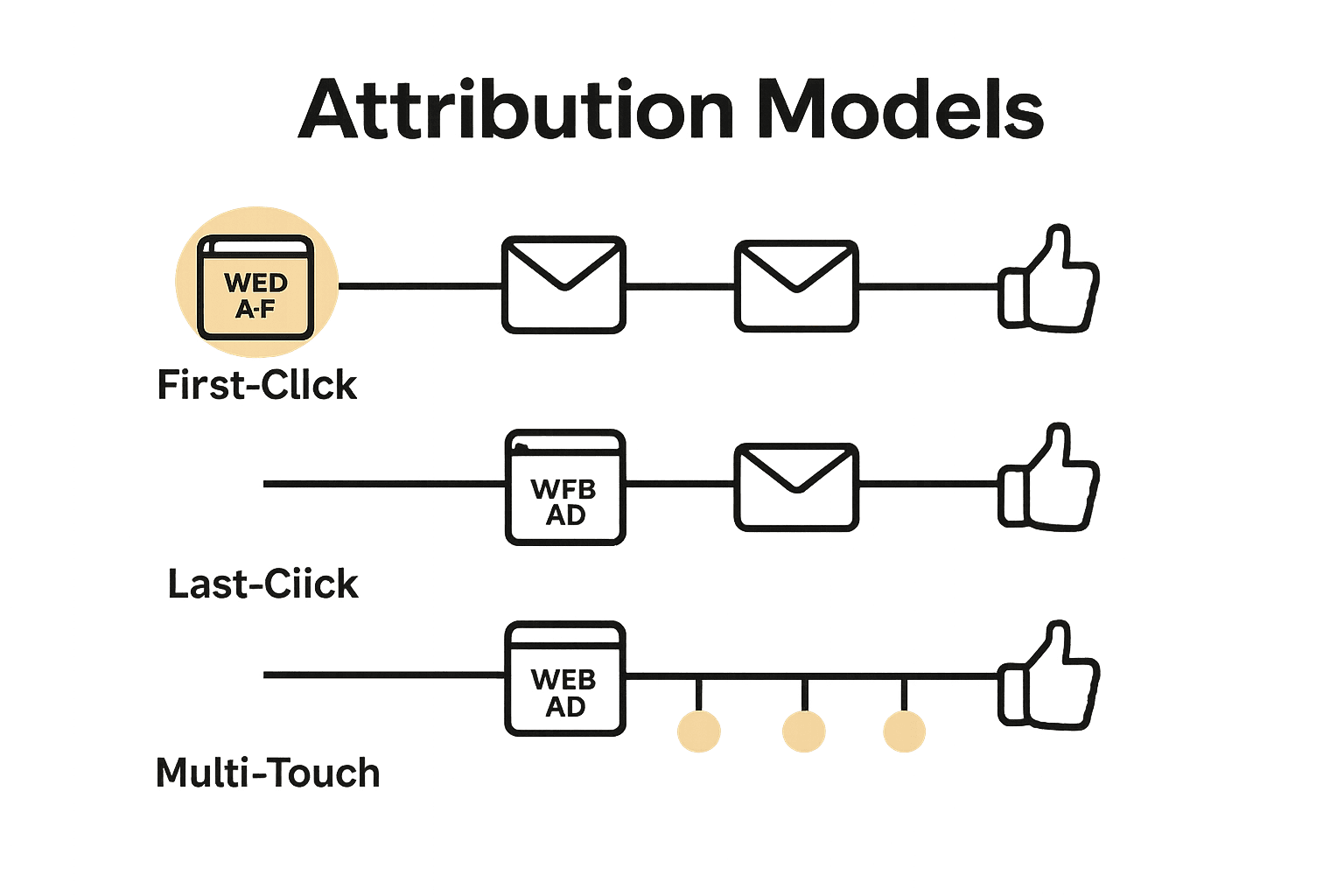Over 80 percent of marketers admit that measuring the true impact of their campaigns is a constant challenge. In a world where prospects connect with brands across dozens of platforms, untangling which touchpoints drive conversions can make or break a strategy. This guide will break down core attribution models, show how they reveal hidden patterns in customer behavior, and provide the clarity needed to make smarter decisions about every marketing dollar.
Table of Contents
- Defining Attribution Models And Core Concepts
- Major Types Of Attribution Models Compared
- How Attribution Works In Conversion Tracking
- Choosing Models For Accurate Data Analysis
- Common Mistakes And Optimization Strategies
Key Takeaways
| Point | Details |
|---|---|
| Attribution Models Are Essential | They help businesses understand the contributions of various marketing channels to customer conversions. |
| Multi-Touch Models Provide Depth | Unlike single-touch models, multi-touch models reveal the complex interactions within the customer journey. |
| Data Complexity Influences Model Choice | Selecting an appropriate attribution model requires consideration of business objectives, data complexity, and resource availability. |
| Avoid Common Mistakes | Businesses should not oversimplify attribution, ignore time sensitivity, or treat channels as independent to improve marketing strategy accuracy. |
Defining Attribution Models and Core Concepts
Marketing attribution is a strategic method for understanding how different marketing channels and touchpoints contribute to customer conversions and sales. According to en.wikipedia.org), attribution models help businesses assign credit to various interactions that ultimately lead to a purchase or desired action.
At its core, attribution modeling tracks the customer journey across multiple platforms and interactions, revealing which marketing efforts are most effective in driving conversions. ArXiv.org highlights that advanced attribution models can capture complex interactions, including direct advertisement effects, ad decay rates, and interactions between different marketing channels.
Key components of attribution models typically include:
- Touchpoint Tracking: Identifying every interaction a customer has with a brand
- Credit Assignment: Determining the value of each marketing channel
- Conversion Path Analysis: Understanding the sequence of interactions leading to a sale
- Performance Measurement: Evaluating the effectiveness of marketing strategies
While traditional single-touch models like first-click or last-click attribution provide basic insights, modern multi-touch models offer a more nuanced understanding of customer conversion paths. These advanced models help marketers allocate resources more effectively by providing a comprehensive view of how different marketing efforts contribute to overall business performance.

Major Types of Attribution Models Compared
Marketing attribution models vary widely in their approach to understanding customer conversion paths. According to en.wikipedia.org), there are several key types of attribution models that businesses can leverage to track and evaluate their marketing performance.
Single-Touch Attribution Models represent the most basic approach to tracking marketing interactions. These models include:
- First-Click Attribution: Gives 100% credit to the first touchpoint in the customer journey
- Last-Click Attribution: Attributes all conversion credit to the final interaction before purchase
Multi-Touch Attribution Models offer a more nuanced approach to understanding customer interactions. ArXiv.org highlights these sophisticated models as critical for capturing complex marketing dynamics. Key multi-touch models include:
- Linear Attribution: Distributes credit equally across all touchpoints
- Time-Decay Attribution: Assigns more credit to interactions closer to the conversion
- Position-Based Attribution: Allocates higher credit to specific touchpoints (e.g., first and last interactions)
The choice of attribution model can significantly impact how businesses understand and optimize their marketing strategies. While single-touch models provide simple insights, multi-touch models offer a more comprehensive view of the customer journey. By understanding the strengths and limitations of each approach, marketers can select the most appropriate model for their specific business needs and understand the challenges in data attribution.

Ultimately, the goal of any attribution model is to provide clear, actionable insights into how different marketing channels contribute to conversions. Businesses must carefully evaluate their unique customer journey, marketing mix, and strategic objectives when selecting an attribution approach.
How Attribution Works in Conversion Tracking
Conversion tracking is the process of monitoring and analyzing how potential customers interact with various marketing channels before making a purchase. ArXiv.org reveals that advanced attribution models use sophisticated neural networks to predict and understand these complex interaction patterns.
Tracking Mechanisms involve capturing and analyzing multiple touchpoints throughout the customer journey. These mechanisms typically include:
- Cookie Tracking: Following user interactions across websites
- Pixel Tracking: Monitoring specific user actions and events
- Device Fingerprinting: Identifying unique user characteristics
- Cross-Platform Tracking: Understanding interactions across different marketing channels
ArXiv.org highlights that modern conversion tracking goes beyond simple linear models, employing advanced neural network approaches like Transformer-based systems. These sophisticated models can capture nuanced interactions and long-term effects that traditional tracking methods might miss.
The core objective of conversion tracking is to provide actionable insights into how different marketing efforts contribute to final conversions. By understanding conversion tracking strategies, businesses can optimize their marketing spend, identify the most effective channels, and create more targeted, efficient marketing campaigns. This approach transforms raw data into strategic intelligence, enabling more informed decision-making across marketing initiatives.
Choosing Models for Accurate Data Analysis
Selecting the right attribution model is a critical decision that directly impacts marketing strategy and business performance. ArXiv.org emphasizes the importance of capturing complex advertisement effects, including direct interactions, decay rates, and customer heterogeneity when choosing an appropriate attribution approach.
Key Considerations for model selection include:
- Business Objectives: Aligning the model with specific marketing goals
- Data Complexity: Assessing the sophistication of your marketing channels
- Customer Journey Length: Understanding the typical conversion path
- Resource Availability: Evaluating technical capabilities for advanced modeling
ArXiv.org highlights that computational tools like Robyn can help organizations mitigate common biases and promote more accurate data analysis. The selection process involves carefully weighing multiple factors to ensure the chosen model provides meaningful insights.
Beyond technical considerations, businesses must also consider organizational acceptance and practical implementation. By exploring best practices for analytics in 2025, marketing teams can develop a more nuanced approach to attribution modeling. The ultimate goal is to create a flexible, adaptable framework that provides clear, actionable insights into marketing performance and customer behavior.
Common Mistakes and Optimization Strategies
ArXiv.org reveals that many businesses encounter significant challenges in attribution modeling, often failing to account for critical nuances in channel interactions and time dependencies. Understanding these common pitfalls is crucial for developing more accurate marketing strategies.
Key Attribution Modeling Mistakes include:
- Oversimplification: Relying exclusively on single-touch models
- Ignoring Time Sensitivity: Failing to weight interactions based on temporal proximity
- Channel Interaction Blindness: Not recognizing how different marketing channels influence each other
- Data Silo Thinking: Treating marketing channels as independent entities
ArXiv.org highlights advanced optimization strategies that leverage neural network approaches to improve sales attribution accuracy. These sophisticated techniques can dramatically enhance model interpretability and provide more nuanced insights into marketing performance.
To mitigate these challenges, businesses should review common tracking mistakes and adopt a more holistic approach to data analysis. The most successful attribution strategies combine advanced computational techniques with a deep understanding of customer behavior, creating a dynamic framework that adapts to changing marketing landscapes.
Unlock the True Power of Attribution with Advanced Conversion Tracking
Understanding the intricacies of attribution models is the first step to improving your e-commerce ROI. The article highlights common challenges such as oversimplification of touchpoints, ignoring the time sensitivity of interactions, and the complexity of tracking across multiple channels. These pain points can leave your marketing efforts blind to crucial data, affecting decision-making and growth potential. To truly optimise your marketing strategies, you need a solution that guarantees accurate, reliable tracking and helps you navigate the complexity of multi-touch attribution.
AdPage offers a powerful platform designed to solve these exact challenges. With server-side tagging, consent management, and seamless integration with platforms like Shopify and WooCommerce, you can monitor 100 per cent of your conversions without data loss. This means gaining deeper insights into your customer journey and confidently assigning credit to every marketing touchpoint. Discover how you can fine-tune your campaigns and boost your return by leveraging precise data analytics.
Looking to master attribution and elevate your e-commerce strategy?

Visit AdPage now to explore how our platform empowers marketers and agencies to transform their conversion tracking. Take control of your data today and start making informed decisions that drive real results.
Frequently Asked Questions
What are attribution models in marketing?
Attribution models are strategic frameworks used to assign credit to various marketing channels and interactions that lead to customer conversions and sales.
How do single-touch and multi-touch attribution models differ?
Single-touch models, like first-click and last-click, attribute all credit to one interaction, while multi-touch models distribute credit across multiple touchpoints for a more nuanced view of the customer journey.
Why is conversion tracking important for e-commerce?
Conversion tracking helps businesses monitor and analyze customer interactions with marketing channels, providing insights into which efforts are effective in driving sales.
What are common mistakes in attribution modeling?
Common mistakes include oversimplifying with single-touch models, ignoring time sensitivity in customer interactions, and failing to recognize how different channels influence each other.



.png)
